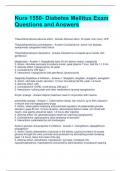Nura 1550- Diabetes Mellitus Exam
Questions and Answers
Thiazolidinendioines adverse effect - Answer-Adverse effect- GI upset, liver injury, CHF
Thiazolidinendioines contradictions - Answer-Contradictions- active liver disease,
symptomatic congestive heart failure
Thiazolidinendioines interactions - Answer-Interactions-increased serum levels with
gemfibrozil
Meglitinides - Answer-1. Repaglinide (take 30 min before meals), nateglinide
2. Action- stimulate pancreas to produce insulin, peak plasma 1 hour, Half life 1-1.5 hrs
3. Adverse effect- hypoglycemia, GI upset
4. Contradictions- DM type 1
5. Interactions- hypoglycemia with gemfibozil, gitraconazole
Dipeptidyl Peptidase-4 Inhibitors - Answer-1. Sitagliptin, alogliptin, linagliptin, saxagliptin
2. Action- stimulate insulin secretion, 12 hour circulating half life, peak 1-4 hours
3. Adverse effect- URI
4. Contradictions- ESRD, renal dosing, DM type 1
5. Interactions- sulfonyureas and other medications causing hypoglycemia
Amylin analogs - Answer-Adjunct treatment used in conjunction with insulins
pramlintide acetate - Answer-1. Taken before meals, can result in up to 50% reduction
in insulin and oral hypoglycemic drugs
2. Action- slows gastric emptying and promoted regulation of postprandial glucose
elevation, peak 20 min, 3 hours duration, administered before meals, not mixed with
insulin, oral agents should be taken 1-2 hours after injection
3. Adverse effect- GI upset(decreases) black box warning-hypoglycemia
4. Contradictions- gastroparesis (slow emptying of stomach)
5. Interactions- potentiated by anti cholinergics
Sodium glucose contransporter 2 inhibitors - Answer-1. Canagliflozin, dapaglkfliozin,
empaglifozin
2. Action- blocks reabsorption of glucose in the kidney, causing excretion of excess
glucose through the urine, promote renal protection by decreasing protein dumping,
peak 1-2 hours, taken first meal of the day
3. Adverse effect- dehydration, hypotension, syncope, increased LDL,
hyperphosphatemia, hyperkalemia (worsened by administration of potassium sparing
, diuretics), hypermagnesium, increased creatinine, increased risk for genital mycotic
infection, and candidiasis
4. Contradictions- hepatic impairment, renal dosing, not recommended if GFR < 45
5. Interactions- worsening hypotension with anti hypertensive medications, St. Wort
causes hyperglycemia
complications of DM - Answer-1. Circulating problems
2. Blindness
3. Renal function impairment
4. Neuropathy in peripherals
What is angiotensin? - Answer-(Cardiac)
Converting enzyme inhibitors-delay renal failure, preserve renal function
What is angiotensin II? - Answer-(Cardiac)
1. Reduce ESRD, reduce progression
What is thiazide diuretics? - Answer-Reduce CV events in DM
What is an anti-platelet agent? - Answer-Prevention of CV events (aspirin, plavix)
What is a HMG-CoA reductase inhibitor? - Answer-Reduce CVD risk in DM2 (statins)
DM1 age of onset - Answer-Young, after 4 years peak increases at 10-12 or 14
DM1 etiology - Answer-Genes and environmental factors, such as viruses
DM2 complications - Answer-MI, HHNS, CVA
DM1 course in the body - Answer-Immune system mistakenly attacks and destroys cells
in your pancreas that makes insulin
DM1 complications - Answer-Heart disease, renal failure, peripheral vascular disease,
diabetic retinopathy
DM1 drug therapy requirements - Answer-Insulin, patients are insulin dependent
DM2 age of onset - Answer-After 40, gradually increases in children and adolecents
DM2 course in the body - Answer-Produces insulin but the body doesn't respond
DM2 etiology - Answer-complex interplay between genetic and environmental factors
lifestyle- excess cals, decrease exercise, obesity
DM2 drug requirements - Answer-Oral anti diabetics, insulin




